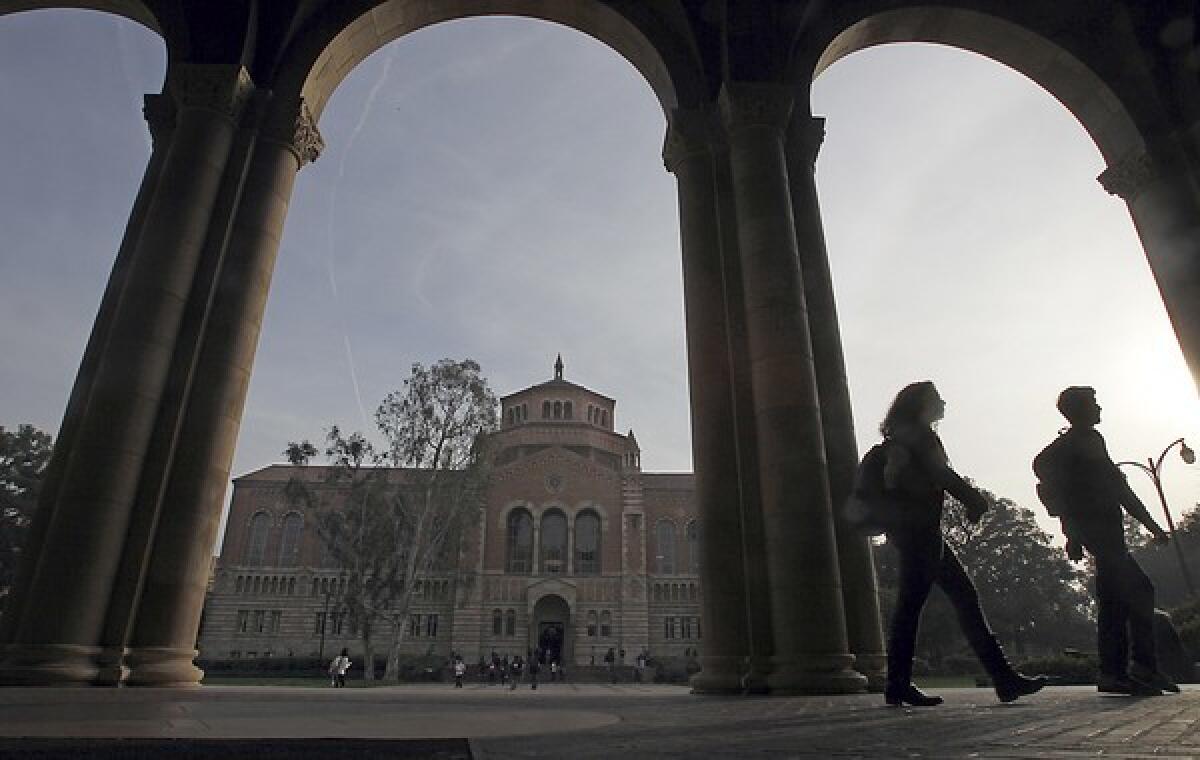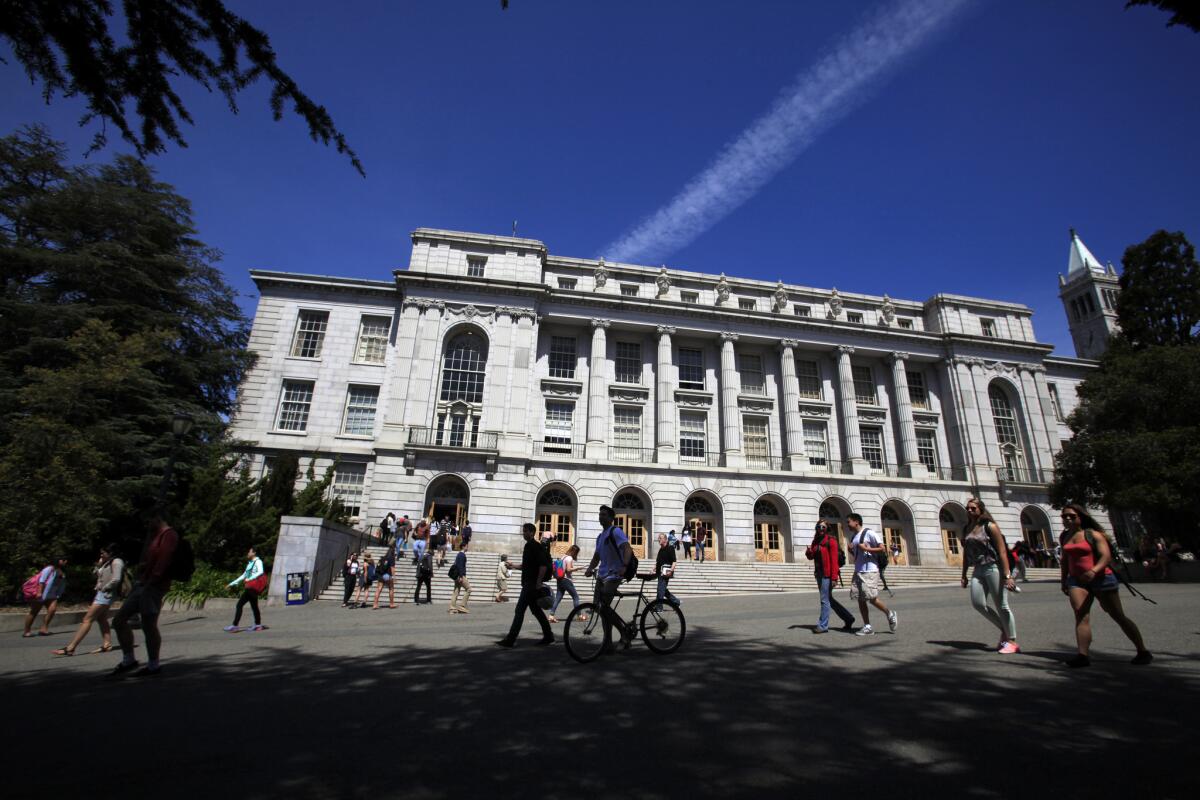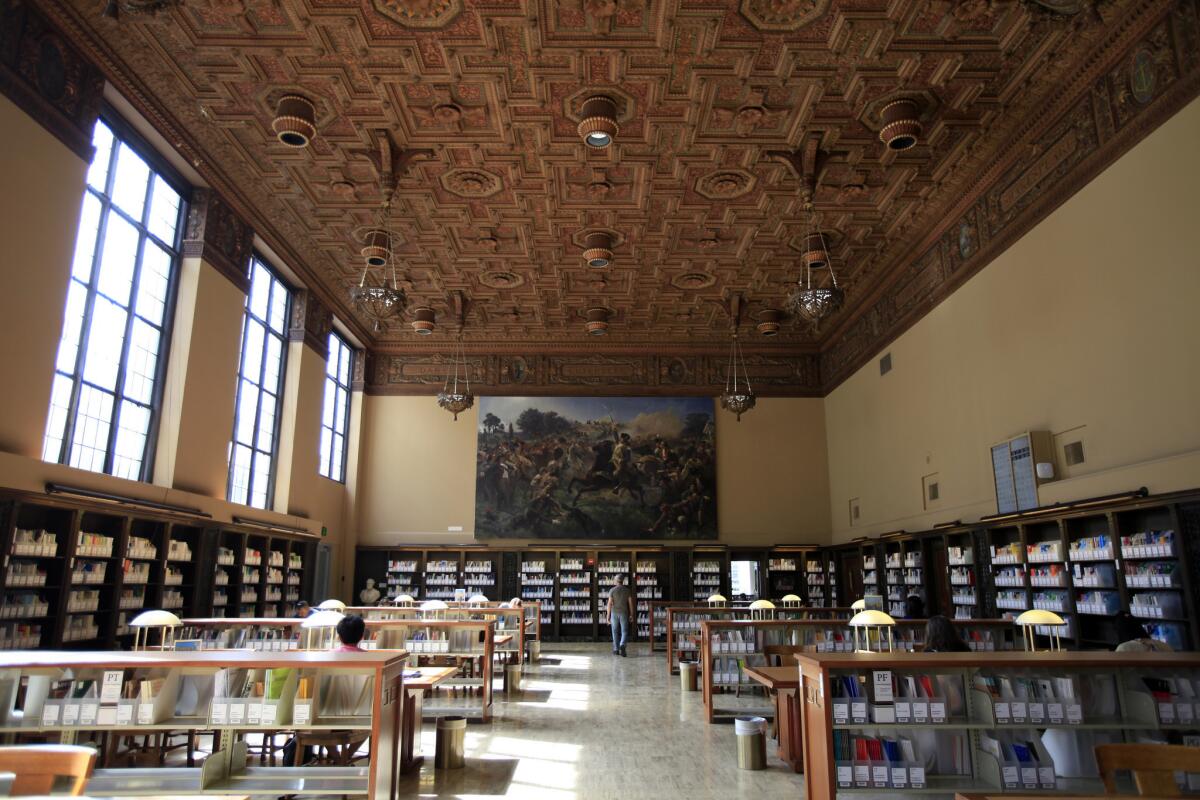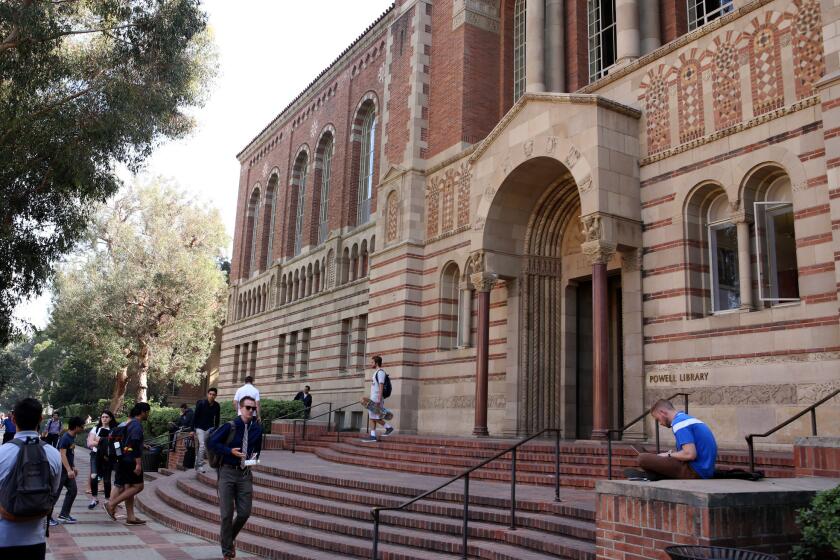Earthquakes could kill people in many UCLA, UC Berkeley buildings, officials say

- Share via
SAN FRANCISCO — Dozens of buildings at UCLA and UC Berkeley pose a serious risk to life in a strong earthquake, with at least 68 seismically deficient structures at UC Berkeley and 18 at UCLA, according to new university studies.
Although no campus buildings were deemed to be in the worst category, “dangerous,” six at UC Berkeley and three at UCLA were found to have a “severe” risk to life. The remaining 62 at UC Berkeley and 15 at UCLA were said to have a “serious” risk to life, according to the first reports released this week in response to a UC Board of Regents 2017 directive calling on every campus to undertake a seismic risk assessment.
Other campuses are still compiling their reports. In general, UC campuses at particular risk of ground shaking in earthquakes include UC Irvine, UC Riverside, UC Santa Barbara, UC Santa Cruz and UC San Francisco.
Some of the UCLA buildings that pose a serious risk to life are the campus’ most significant — the Young and Powell libraries, which are large and highly populated; Murphy Hall, home to campus administrators; and the Luskin School of Public Affairs building, where hundreds attend humanities classes.
UCLA, attended by 45,500 undergraduate and graduate students, is threatened by the Santa Monica fault, which runs along Santa Monica Boulevard, and the Newport-Inglewood fault, which runs from Orange County through Baldwin Hills and ends near campus. Each fault is capable of producing a quake of magnitude 7 or greater.
UC Berkeley, which serves about 42,500 undergraduate and graduate students, must contend with the Hayward fault, which runs through the campus’ eastern section and has the potential to unleash an earthquake of greater than magnitude 7.
Some of the six buildings believed to pose a severe risk to life are also among UC Berkeley’s most important — the 1960s-era Moffitt Library and the massive 11-story Evans Hall, which houses the math, statistics and economics departments and is within sight of the university’s iconic Campanile clock tower.
A list of UCLA and UC Berkeley buildings that are seismically unsafe during a major earthquake.
Buildings with a severe risk to life are defined in the university studies as having a “very poor” seismic performance, where the cost to make repairs would be 40% to 100% of the cost to rebuild it from scratch. Those with a serious risk to life are deemed to have a “poor” seismic performance, and repairs would range between 20% to 50% of the cost to rebuild it.
Initial estimates suggest the price of repairing or replacing the buildings at UC Berkeley alone would be in excess of $1 billion.
Claire Doan, spokeswoman for the UC Office of the President, said UC is working with the California State University system and state lawmakers on a possible general-obligation bond measure for the 2020 ballot that would provide some funds for earthquake retrofit projects. A current draft of Senate Bill 14 would ask voters to approve an $8-billion bond for construction and reconstruction of UC and Cal State buildings, with priority given to seismic retrofits.
The UC system’s Capital Financial Plan through 2028 already includes more than $2 billion in seismic-related projects.
The new estimates send a stark warning about the vulnerability of California communities in an earthquake.

UCLA and UC Berkeley have been leaders in seismic retrofits for decades. UCLA has spent more than $2.8 billion, and UC Berkeley, more than $1 billion, on retrofits — strengthening buildings that are particularly at risk of extensive damage.
But new research over the past quarter-century has shown that, at least for the Berkeley campus, the severity of potential shaking is much worse than previously believed, said Filip Filippou, a UC Berkeley professor of structural engineering and chair of the campus seismic review committee from 2001 to 2017.
For instance, Moffitt Library was seismically retrofitted in 1992, and experts think the building could withstand small or moderate levels of shaking. But new research and a generation of better observations of recent earthquakes has shown that the potential for ground shaking at that site is much worse than previously understood, and the library’s columns could fail in severe shaking.
“We have learned a lot more about what shaking intensity could be, and it’s higher than what we thought 30 years ago,” said Jack Moehle, UC Berkeley professor of structural engineering and chair of the seismic review committee.
The magnitude 6.7 Northridge earthquake of 1994, for instance, was one of the first earthquakes to be observed with a dense array of instruments, and the shaking intensity was bigger than what scientists had expected, Moehle said.
At UC Berkeley, the intensity of potential shaking is perhaps double or triple what was once thought to be possible. That means a building that may have passed a seismic test a quarter-century ago might be at risk of collapse today.
Retrofit standards have significantly improved since the 1990s, and today’s computing technology allows engineers far better tools to identify flaws in a building’s design, Filippou added.
The 1992 retrofit of Moffitt Library, for instance, did strengthen the brittle concrete building with the addition of thick concrete walls and new foundations to help keep the building from collapsing when shaken, said David Mar, a structural engineer hired by UC Berkeley to evaluate the building.
But today’s seismic evaluation techniques showed that at Moffitt, without a retrofit of the building’s columns with some kind of strong jacket, made of steel, concrete or carbon-fiber, it’s possible that concrete could come exploding out of the columns when shaken and the building could collapse.
Engineers said the results of these analyses are serious and need to be resolved to ensure the survival of UC campuses. But it’s possible to do it, they said, pointing to California’s historic effort to retrofit or replace dangerous freeways and bridges following deadly collapses in the magnitude 6.9 Loma Prieta earthquake of 1989 and the magnitude 6.7 Northridge earthquake of 1994.
“I don’t think the campus can afford not to do anything. It could be lethal for the survival of the campus,” Filippou said.
“Can you imagine if Moffitt Library collapsed a week before finals? This would be a tragedy of huge proportions,” said Jonathan P. Stewart, UCLA professor of civil engineering. Not only would many young people die, but a wrecked campus would also be a loss to groundbreaking research and a big driver of the California economy.
The seismic rankings may still fluctuate as buildings are studied further. So far only the largest buildings on the campuses have been assessed. More analysis may reveal some buildings are safer, while other buildings may be deemed more hazardous.
Among structures that have not yet undergone renewed study is UC Berkeley’s landmark Campanile, also known as Sather Tower, which had been previously designated as being a “serious” risk to life in an earthquake.
UCLA Vice Chancellor Gregg Goldman said the campus hopes to receive construction funding through the possible state bond measure. “UCLA’s top priority continues to be the safety and well-being of its students, faculty, staff and visitors,” he said in a statement.
In a campus email Wednesday, UC Berkeley Chancellor Carol Christ said the campus was submitting its preliminary findings to the UC Office of the President as officials begin “a coordinated, systemwide effort to holistically prioritize and address the work that will need to be done on hundreds of buildings on the 10 UC campuses.”

“Before remediation can proceed, experts must first determine the best option — retrofit, replace or vacate — for each of the seismically deficient buildings,” she said.
In the meantime, she added, UC Berkeley will review “available, realistic options to limit occupancy and usage of seismically deficient buildings on our campus.”
The other buildings at UC Berkeley believed to pose a severe risk to life are Durant, Stephens and Wellman halls, and the Donner Lab addition.
Among the buildings believed to be a serious risk to life are California Hall, which is home to the chancellor’s office; the Cesar E. Chavez Student Center; the Doe Memorial Library; North Gate Hall, which houses the School of Journalism; Sproul Hall; the Valley Life Sciences Building; Wheeler Hall; Wurster Hall; and Zellerbach Hall.
The other UC campuses have not yet released their studies, which involve the largest buildings. The last phase of the evaluation will include smaller structures.
The 23-campus Cal State University system has not ordered a report similar to what UC regents asked for, said Michael Uhlenkamp, a spokesman. The CSU system issues a Seismic Safety Annual Report, but officials are considering if they, too, should undertake its own systemwide assessment. Half of Cal State buildings are 40 years old or older. Cal State has spent $630 million on seismic retrofits over the last five years, and plans an additional $900 million for the next five years.
Lin reported from San Francisco, Reyes-Velarde from Los Angeles.
More to Read
Sign up for Essential California
The most important California stories and recommendations in your inbox every morning.
You may occasionally receive promotional content from the Los Angeles Times.













